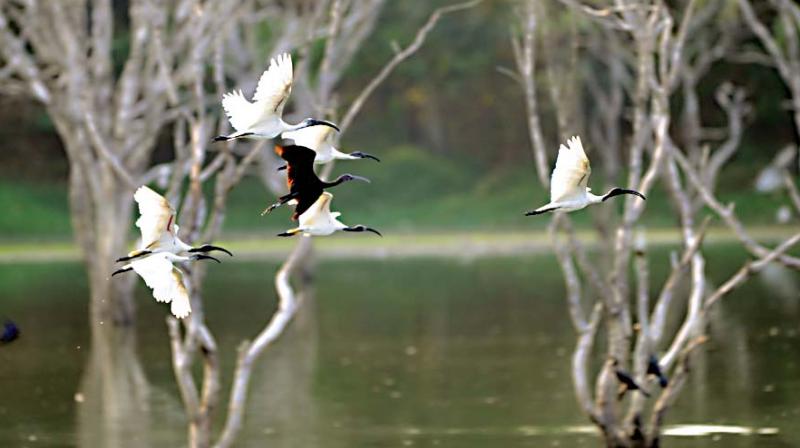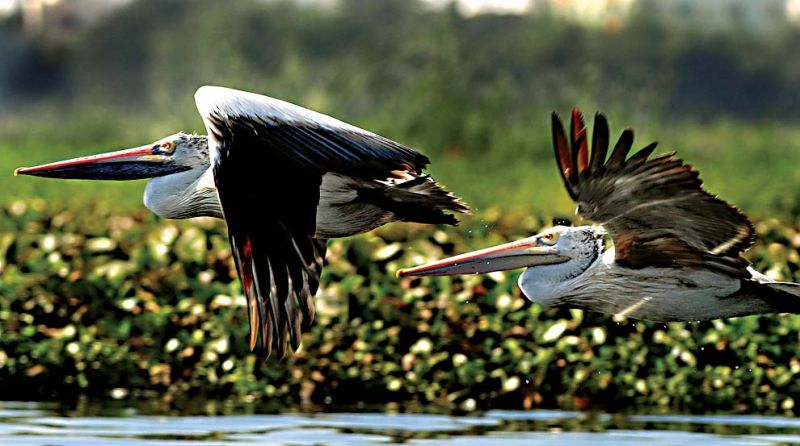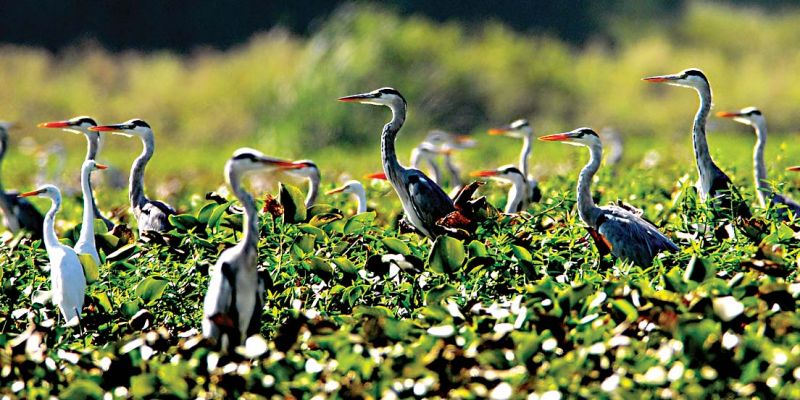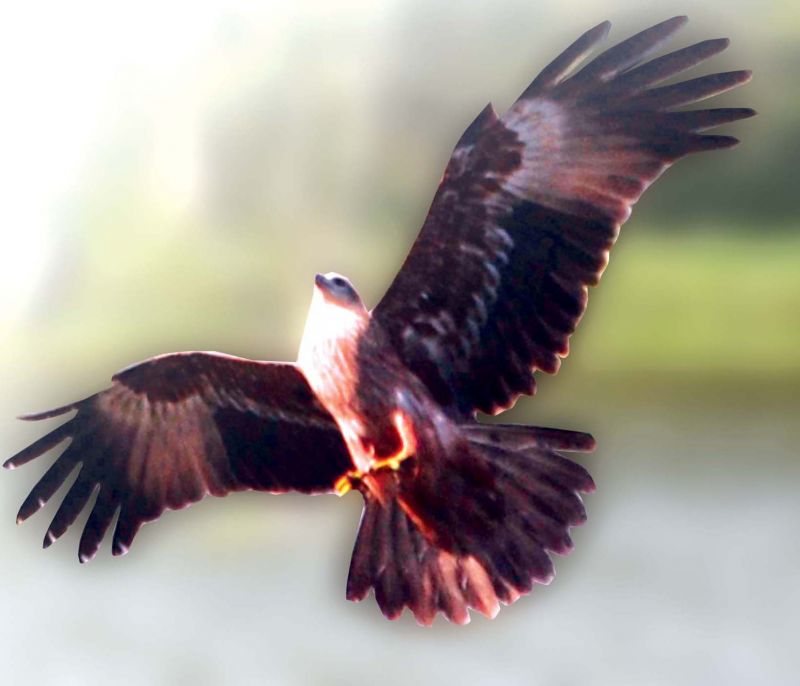Providing a safe haven for winged visitors
Karnataka Forest Department plans to partner with the Bombay Natural History Society to ring and collar migratory birds.

Bengaluru is a city every corporate could be proud of only if its lakes wear a pristine and sparkling look devoid of sewage and stench. And if biotech major Biocon can bring the Hebbagodi Lake back to life with a generous infusion of funds, why can’t others do their bit and bring back the winged beauties which once madethe IT city’s water bodies their home? Aksheev Thakur reports
A recent report that the Karnataka Forest Department plans to partner with the Bombay Natural History Society to ring and collar migratory birds reveals what is perhaps the first of such efforts in the state. The initiative, which is expected to be taken in the backwaters of the Tungabhadra reservoir and Magadi tank in North Karnataka, should restore the focus on habitat conservation and humanity’s role in bird migration.
Many species of birds fly long distances to avoid the cold weather and poor food availability in the higher latitudes in winter. They fly towards the equator and spend the winter in warmer climates. On the approach of summer, they fly back to the countries they came from, to make use of the longer days there to get access to food and breed. So bird migration is seasonal and India too sees huge numbers arrive every year.
 Madivala Lake - Spotted Pelicans or Dalmatian Pelicans.
Madivala Lake - Spotted Pelicans or Dalmatian Pelicans.
It is believed that by the Meiocene epoch - pegged between five and 23 million years ago- in earth’s history, bird migration was already in place. Considering that the Himalayas arose during the Meiocene epoch, bird migration is many times older than the advent of humans on earth.
Migratory birds generally start arriving in September-October to our part of the country and stay on till April before beginning their journey back. Fast flying birds like ducks and shorebirds come early, sometimes by the end of August.
But there are some long distance non- stop flyers too. Satellite tracking has shown that the Godwits, which fly between Alaska and Australia, cover some nine to 11,000 kms non-stop, without food, water or sleep over the Pacific. The young of the Common Swifts of Europe also keep flying continuously day and night for one-and-a-half to two years feeding, drinking and bathing on the wing till they come back to build their own nests and raise their young. In this time they also complete a migration trip to Southern Africa and back!
 Kaikondrahalli Lake - Ibis
Kaikondrahalli Lake - Ibis
In this whole process of bird migration, we the humans as a species, play an important part. As the earth’s greatest invasive species, we are destroying natural habitats faster than ever before. If we destroy habitats, especially the staging and feeding grounds, these birds will be put at a very heavy disadvantage. Without building adequate fat and nutritional reserves, they will be at a loss, and their population will suffer. It is therefore our responsibility to ensure their survival.
— Dr Krishna M.B.
Tracking aerial journey of birds
For a very long time, our understanding of the endurance of birds during migration was largely through observations and a process of what is called ringing. A small ring bearing a number and address would be slipped on a bird’s foot. When this ring was recovered or the bird captured elsewhere, we would know about the movement and timing. The locations of the different sites and the dates of ringing and recovery would give an indication of the speed and distance of migration. In India, this work was largely done by the Bombay Natural History Society. All this changed with newer technology. The process of putting a small transmitter (technically called a platform terminal transmitter), whose signals would be received directly by orbiting satellites and relayed back to receiving stations, started throwing up real time information. Though it was quite revealing, but it is very costly. A via media between ringing and satellite tracking, and a more affordable technique, for large birds like bar-headed geese, would be the bold neck bands with very ‘visible’ numbers. Our local photographers have done a remarkable job in photographing such marked geese in our lakes. By this information, the photographed birds are traced back to the place where they were banded. Apart from barheaded geese, other birds bearing bands like great knots have also been photographed in India.
More CSR initiatives needed to save the city’s water bodies
On Sunday, as part of its efforts to clean up the city's environment, Biocon Foundation proudly announced that it had brought back to life the dying 35-acre Hebbagodi Lake.
And a few months ago, in April, an NGO, SayTrees joined hands with a private firm, HP Inc. to revive the 16 acre Vabasandra Lake and accomplished the restoration in July.
 Kaikondrahalli Lake -Marsh Harrier
Kaikondrahalli Lake -Marsh Harrier
These are only two examples of an increasing number of corporates now coming forward to help restore the city's dying water bodies, which once took care of its water supply and groundwater table and contributed to its salubrious weather.
If Bengaluru owes its founding father, Kempegowda's foresight in building these inter-connected water bodies for the many lakes it still has today in its midst (despite losing several to so-called development), it has several corporates to thank for ensuring their survival despite the sewage that is constantly let into them from their surroundings.
Fortunately, some private firms seriously follow the diktats of The Companies Act of 2013 , which has made it mandatory for all listed companies with annual sales of Rs 500 crore or annual profits of Rs 100 crore to set aside two percent of their profit for their Corporate Social Responsibility (CSR) projects. Last week, Union Petroleum Minister, Dharmendra Pradhan too advised corporates to spend upto 10 per cent of their profits on socially relevant work.
This has come in handy for the city as the BBMP often blames a lack of funds for its failure to clean up its lakes. Over the last few years, several companies have joined hands with non-governmental organisations (NGO) to breathe fresh life into many dying lakes across the city and its outskirts.
Clearly happy with her company's involvement in the cause, chairperson and managing director of Biocon, Kiran Mazumdar-Shaw says CSR can be directed to environmental issues like rejuvenation of lakes. "Companies should also concentrate on important things like ensuring clean air as this will help us go a long way in improving the lives of the people,” she suggests.
Founder of SayTrees, Kapil Sharma, believes corporates not only need to fund the rejuvenation of lakes, but also support their year on year maintenance for their long time survival. "This will ensure that lakes neglected for long owing to shortage of funds survive for years to come,” he explains.
The government-owned Bharat Electronics Limited (BEL) seems to be doing just this as not only did it spend Rs 14 crore earlier this year on setting up a 10 MLD Sewage Treatment Plant (STP) to revive the Doddabommasandra Lake, but it has also taken on the responsibility of maintaining it for the next 20 years.
The corporates involved do need to get approval from the Karnataka Lake Conser vation and Development Authority (KLCDA) and other authorities to play good Samaritans, but it is not hard to come by as the government is only too happy to have them support it in a cause so dear to the city.

